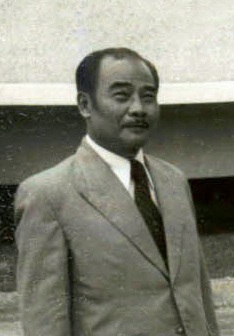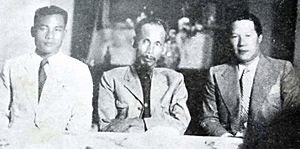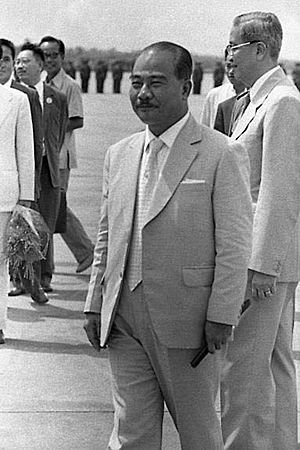Souphanouvong facts for kids
Quick facts for kids
Prince Souphanouvong
|
|||||||||||||||||||||||||||||||||||||||||||||||||||||||||||||||||||||||||||
|---|---|---|---|---|---|---|---|---|---|---|---|---|---|---|---|---|---|---|---|---|---|---|---|---|---|---|---|---|---|---|---|---|---|---|---|---|---|---|---|---|---|---|---|---|---|---|---|---|---|---|---|---|---|---|---|---|---|---|---|---|---|---|---|---|---|---|---|---|---|---|---|---|---|---|---|
|
ສຸພານຸວົງ
|
|||||||||||||||||||||||||||||||||||||||||||||||||||||||||||||||||||||||||||

Souphanouvong c. 1978
|
|||||||||||||||||||||||||||||||||||||||||||||||||||||||||||||||||||||||||||
| 1st President of Laos | |||||||||||||||||||||||||||||||||||||||||||||||||||||||||||||||||||||||||||
| In office 2 December 1975 – 29 October 1986 |
|||||||||||||||||||||||||||||||||||||||||||||||||||||||||||||||||||||||||||
| Prime Minister | Kaysone Phomvihane | ||||||||||||||||||||||||||||||||||||||||||||||||||||||||||||||||||||||||||
| Preceded by | Sisavang Vatthana | ||||||||||||||||||||||||||||||||||||||||||||||||||||||||||||||||||||||||||
| Succeeded by | Phoumi Vongvichit (Acting) | ||||||||||||||||||||||||||||||||||||||||||||||||||||||||||||||||||||||||||
| President of the Standing Committee of the Supreme People's Assembly | |||||||||||||||||||||||||||||||||||||||||||||||||||||||||||||||||||||||||||
| In office 2 December 1975 – 25 November 1986 |
|||||||||||||||||||||||||||||||||||||||||||||||||||||||||||||||||||||||||||
| Prime Minister | Kaysone Phomvihane | ||||||||||||||||||||||||||||||||||||||||||||||||||||||||||||||||||||||||||
| Preceded by | Position established | ||||||||||||||||||||||||||||||||||||||||||||||||||||||||||||||||||||||||||
| Succeeded by | Sisomphone Lovansay (Acting) | ||||||||||||||||||||||||||||||||||||||||||||||||||||||||||||||||||||||||||
|
|||||||||||||||||||||||||||||||||||||||||||||||||||||||||||||||||||||||||||
|
|||||||||||||||||||||||||||||||||||||||||||||||||||||||||||||||||||||||||||
| Personal details | |||||||||||||||||||||||||||||||||||||||||||||||||||||||||||||||||||||||||||
| Born | 13 July 1909 Palace Sisouvanna, Xieng Dong, Luang-Prabang, French Laos |
||||||||||||||||||||||||||||||||||||||||||||||||||||||||||||||||||||||||||
| Died | 9 January 1995 (aged 85) Vientiane, Laos |
||||||||||||||||||||||||||||||||||||||||||||||||||||||||||||||||||||||||||
| Citizenship |
|
||||||||||||||||||||||||||||||||||||||||||||||||||||||||||||||||||||||||||
| Nationality | Laotian | ||||||||||||||||||||||||||||||||||||||||||||||||||||||||||||||||||||||||||
| Political party | Lao People's Revolutionary Party | ||||||||||||||||||||||||||||||||||||||||||||||||||||||||||||||||||||||||||
| Other political affiliations |
Lao Front for National Development | ||||||||||||||||||||||||||||||||||||||||||||||||||||||||||||||||||||||||||
| Spouse |
Nguyen Thi Ky Nam
(m. 1938) |
||||||||||||||||||||||||||||||||||||||||||||||||||||||||||||||||||||||||||
| Relations | Lao Royal Family | ||||||||||||||||||||||||||||||||||||||||||||||||||||||||||||||||||||||||||
| Parents |
|
||||||||||||||||||||||||||||||||||||||||||||||||||||||||||||||||||||||||||
| Relatives |
|
||||||||||||||||||||||||||||||||||||||||||||||||||||||||||||||||||||||||||
| Education |
|
||||||||||||||||||||||||||||||||||||||||||||||||||||||||||||||||||||||||||
| Alma mater | |||||||||||||||||||||||||||||||||||||||||||||||||||||||||||||||||||||||||||
| Occupation |
|
||||||||||||||||||||||||||||||||||||||||||||||||||||||||||||||||||||||||||
| Awards | See list | ||||||||||||||||||||||||||||||||||||||||||||||||||||||||||||||||||||||||||
| Nickname | Red Prince | ||||||||||||||||||||||||||||||||||||||||||||||||||||||||||||||||||||||||||
| Military service | |||||||||||||||||||||||||||||||||||||||||||||||||||||||||||||||||||||||||||
| Allegiance | |||||||||||||||||||||||||||||||||||||||||||||||||||||||||||||||||||||||||||
| Commands | Commander | ||||||||||||||||||||||||||||||||||||||||||||||||||||||||||||||||||||||||||
| Battles/wars |
|
||||||||||||||||||||||||||||||||||||||||||||||||||||||||||||||||||||||||||
Prince Souphanouvong (born July 13, 1909 – died January 9, 1995) was an important leader in Laos. He was known as the Red Prince. He was one of three important princes who led different groups in Laos. His half-brother, Prince Souvanna Phouma, led a neutral group. Prince Boun Oum led a royalist group. Souphanouvong led the communist group. He later became the first President of Laos in December 1975 and served until 1991.
Contents
Early Life and Education
Souphanouvong was born in Luang Prabang, a city in Laos. His father was Prince Bounkhong, who was a high-ranking official called a viceroy. A viceroy is like a governor who rules a country or province as the king's representative. Souphanouvong's mother was not from a royal family.
He went to school in Hanoi, Vietnam. Then, he studied engineering in Paris, France. He learned how to build bridges and roads. After finishing his studies in 1937, he returned to Southeast Asia. He worked as a civil engineer until 1945, helping to build roads and bridges in Vietnam and Laos.
Fighting for Independence
Joining the Anti-Colonial Movement

After World War II, Laos was still under French rule. Souphanouvong wanted Laos to be free. He met with Ho Chi Minh, a leader from Vietnam, who also wanted his country to be independent. Souphanouvong joined a group called Lao Issara. This group wanted to free Laos from French control.
He became a leader in the Lao Issara movement. He was a foreign minister and a commander of their army. Souphanouvong believed that Laos should work with Vietnam to fight against the French. In 1945, he signed an agreement for the Lao Issara and Viet Minh to help each other.
In 1946, Souphanouvong and his forces lost a battle against the French. He was hurt and had to leave Laos. He lived in Bangkok, Thailand, for three years. In 1949, he left his role as foreign minister because of disagreements about working with the Viet Minh.
Leading the Pathet Lao
In 1950, Souphanouvong started a new group called the Pathet Lao. This group also wanted to free Laos from French rule. The Pathet Lao was supported by North Vietnam. Souphanouvong became the president of the Pathet Lao. This is how he got the nickname "The Red Prince."
Even though he was a leader, another politician named Kaysone Phomvihane was the main leader of the Pathet Lao. Souphanouvong was more of a public figure for the group.
Souphanouvong joined the Lao People's Party in 1955. This party later became the Lao People's Revolutionary Party. He also became the chairman of the Lao Patriotic Front in 1956. This group included different organizations like worker and farmer groups.
From 1957 to 1958, Souphanouvong was a minister in the government. He worked on planning and rebuilding the country. In 1958, he was elected as a member of the National Assembly of Laos. He received the most votes of any candidate.
However, the government later changed. Souphanouvong and other Pathet Lao leaders were arrested in 1959. But in 1960, they managed to escape. Souphanouvong continued to work for peace. He helped with talks that led to an agreement in 1962 to make Laos a neutral country.
In a new government, Souphanouvong became Deputy Prime Minister and Minister of Economy and Planning. But after a political leader was killed in 1963, Souphanouvong left the government. He went back to the Pathet Lao base.
He continued to try and bring different groups together to end the Laotian Civil War. This war deeply affected him, as his oldest son was killed during it. In the early 1970s, he was involved in more talks. These talks led to another government where he helped guide policies.
President of the Lao People's Democratic Republic
In 1975, the Pathet Lao successfully took control of Laos. Souphanouvong became the first President of the Lao People's Democratic Republic. He held this important position until 1991. After 1986, Phoumi Vongvichit took over some of his duties, but Souphanouvong remained the official president. Kaysone Phomvihane became president after him in 1991. Souphanouvong also served as the President of the Supreme People's Assembly from 1975 to 1988.
In 1991, he became an adviser to the Party's Central Committee.
Later Life and Family
Souphanouvong was married to Le Thi Ky Nam, a woman from Vietnam. They had ten children together. Souphanouvong was very smart and could speak eight different languages, including Greek and Latin.
He passed away on January 9, 1995, in Vientiane, the capital of Laos. He died from heart disease. After his death, the government of Laos declared five days of mourning to honor him.
Today, Souphanouvong is remembered as a hero in Laos. He is celebrated for his role in the revolution, for helping Laos gain independence, and for working to keep peace. His remains were moved to a national cemetery in Vientiane in 2012.
Honours and Awards
Souphanouvong received many awards from different countries:
 Laos:
Laos:
 People's Republic of Bulgaria:
People's Republic of Bulgaria:
 Cuba:
Cuba:
 Czechoslovakia:
Czechoslovakia:
 Mongolian People's Republic:
Mongolian People's Republic:
 Soviet Union:
Soviet Union:
 Vietnam:
Vietnam:
Images for kids
-
Souphanouvong (left) with Viet Minh leader Ho Chi Minh (center) and former emperor of Vietnam Bảo Đại
See also
 In Spanish: Souphanouvong para niños
In Spanish: Souphanouvong para niños




